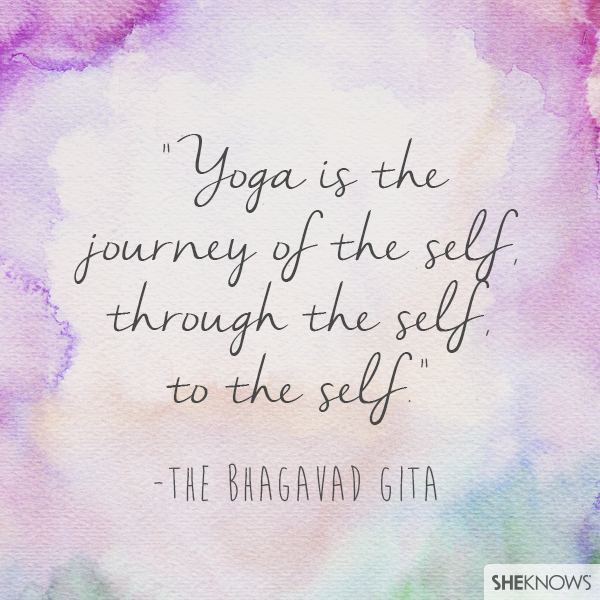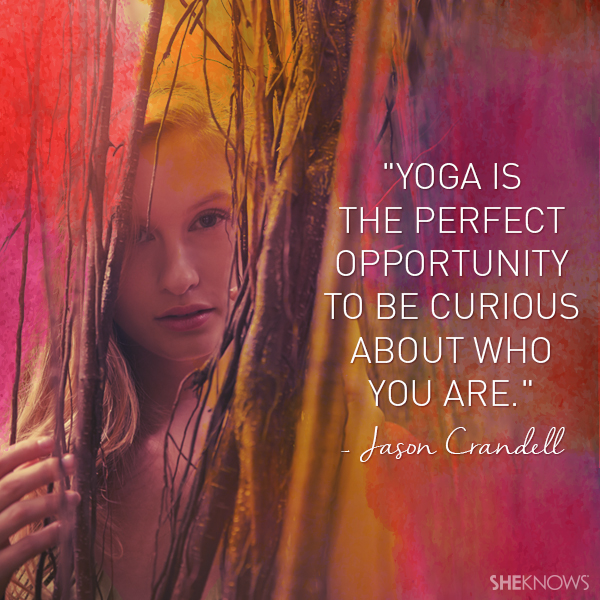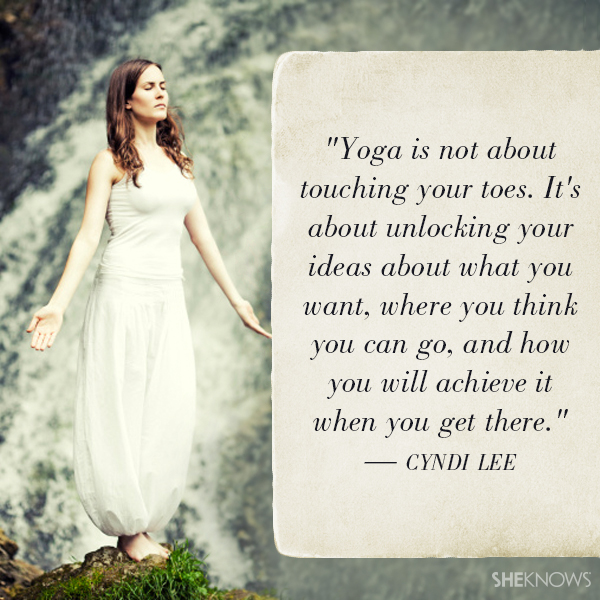“Yoga as a Research Methodology”
Lesson Plan:
Daniel Helman & Julie Malone
Professor:
Joan Clingan
PhD Program - Prescott College

Welcome!
Creative exploration ahead ...
Introduction:
Yoga, meaning “union,” was originally a
Hindi spiritual path. It posed a
question: How does one experience the breath, mind, or divine?
Yoga is also a world-wide modern
practice, and the traditions and practices are continually being updated. Even now, yoga is emerging as a research
methodology—one that focuses on the internal mind—for research on the forms of
thought and relaxation. You may note
that yoga can create a relaxing and stress-free atmosphere as you begin to
write or do other activities throughout the process. If you find yourself under stress—slow down,
back off, and take a few breaths to recenter yourself. This is a journey that you are in charge of.
This mini-course will present material
about yoga practice and philosophy for those who are not familiar with it, but
the focus will ultimately be on how to use these philosophies as a research
methodology. Don’t despair. The first part is very heavy on practice and
philosophy. You won’t just be learning
about how others create yoga methodology.
You’ll be steeped in the thoughts and practice yourself.
If it helps to have an initial look at
yoga as a methodology, you don’t have to wait until week two. The methodology papers are on page 14, and the
methodology practice we’ll explore is on page 16. If you know that you hate surprises, have a
look early to see what you’ll be focused on.
Ultimately, we’ll be doing a process
that:
(1) Makes the
primary focus of the research internal.
You’ll be writing
a brief research communication that is in a form other than an expository
journal article, e.g. as poetry.
(2) Lets the
research design be emergent and leads to health.
You should feel
free to adjust your practice to fit with any new observations.
(3) Lets there be
a focus on breathing.
(4) Includes
elements from the yoga tradition.
The work itself is meant to be
yours. Interpret and reinterpret as
suits the person that you are.
We invite you to join in our mini-course
to take a closer look at yoga as a research methodology and, depending on your
sentiments, learn how to incorporate the practice into your research.
Objectives:
Gain familiarity with yoga.
Positive experience of yoga.
Educate oneself on how yoga can assist in
your personal and professional daily activities.
Know what elements that a person would
need to run research using a yoga methodology.
(1) Follows in a tradition of yoga
(2) Outcome is predominantly internal.
(3) Supernatural is presumed as a
possibility.
(4) Examples of yoga as a method.
(5) Examples of yoga as a methodology.
Familiarity with other people who have
run yoga as a research methodology.
(1) Exemplary yogis.
(2) Researchers.
Knowledge of how to teach yoga.
(1) Teacher principles.
(2) How to find work.
Experience using yoga as a research
methodology.
Positive sharing of that experience.
What
is Yoga?

Why Yoga? It is good for you. Yoga helps with the blood pressure, anxiety,
depression, headaches, bodily aches and pains, and the list goes on. There might be more. It’s a personal choice.
Key
Terms:
Yoga, research, methodology
Scholarly
Resources:
Anderzén-Carlsson, A.,
Lundholm, U., Köhn, M., & Westerdahl, E. (2014). Medical yoga: Another way
of being in the world - A phenomenological study from the perspective of
persons suffering from stress-related symptoms. International Journal Of Qualitative Studies On Health And Well-Being,
9. doi:http://dx.doi.org/10.3402/qhw.v9.23033
Chopra, M.D., Deepak, &
Simon, M.D., David. (2004). The Seven Spiritual Laws of Yoga. New Jersey:John
Wiley & Sons, Inc. Retrieved from
Mishra, S. K., Singh, P.,
Bunch, S. J., & Zhang, R. (2012). The therapeutic value of yoga in
neurological disorders. Annals Of Indian
Academy Of Neurology, 15(4), 247-254. doi:10.4103/0972-2327.104328
Razza, R., Bergen-Cico, D., &
Raymond, K. (2015). Enhancing preschoolers' self-regulation via mindful yoga. Journal Of Child & Family Studies, 24(2),
372-385. doi:10.1007/s10826-013-9847-6
Sherman, K. J., Wellman, R. D.,
Cook, A. J., Cherkin, D. C., & Ceballos, R. M. (2013). Mediators of yoga
and stretching for chronic low back pain. Evidence-Based
Complementary & Alternative Medicine (Ecam), 1-11.
doi:10.1155/2013/130818
Tul, Y., Unruh, A., & Dick, B.
D. (2011). Yoga for chronic pain management: a qualitative exploration. Scandinavian Journal Of Caring Sciences, 25(3),
435-443. doi:10.1111/j.1471-6712.2010.00842.x
Yoga for college students: An
empowering form of movement and connection. (2015). Physical Educator, 72(1), 44-66. Retrieved from http://eds.b.ebscohost.com/eds/pdfviewer/pdfviewer?vid=16&sid=ba482df2-93bd-4fcc-8419-d43ca172f4cb%40sessionmgr115&hid=113
A
Few Types of Yoga:

Hatha – Union of opposites through asana and
breath; hatha literally means Sun-Moon.
Tantha – Separation in union; also called tantra.
Laya – Meditation on energy centers in the body;
associated with Kundalini (Sikh) yoga.
Mantha – Union through sound; also called mantra.
Raja – Union through philosophy.
Jñana – Union through meditation.
Karma – Union through a sense of duty.
Bhakti – Union through loving service to
living creatures.
Joining
Together:
Take a deep breath, sit a little deeper
into your seat, and get ready for some joyful exploration. The activities assembled here are designed
with your growth in mind. That may seem
like a contradiction, as perhaps you have some emergent ideas that haven’t been
included. Of course you have some
emergent ideas that haven’t been included!
This is your exploration. Yours
completely. Flexibility isn’t just for
limbs and trunks. It’s also a part of
how yoga works.
Don’t do anything that doesn’t seem right
for you. You know your body and heart
best. Trust yourself. Really, you’re the expert here.
Take heart.
What to expect:
We’ve included a set of activities to
familiarize you with yoga. That means
you’ll probably end up doing some yoga.
Spend a little time making yourself ready for the journey.
Look inside. Is this going to be your first experience
with yoga? Or, are you seasoned
practitioner? Or somewhere in between? Begin where you are.
There is a section entitled Yoga
Resources on page 11 of this document.
It has links and materials for developing your yoga practice. The resources are divided by type. Breathwork, for example, is its own
category. There are two categories, and
twelve sets of resources.
Suppose an instruction asks you to do
some work with your breath. You can do
some practice that you already know, and are comfortable with. You can look to Yoga Resources (in the
Breathwork section) for a practice instead.
It’s entirely up to you.
The work itself is divided between
becoming familiar with two worlds, the world of yoga, and the world of
research. Perhaps they will both connect
with you. That is our hope. That has been our experience.
A word about terms:
This lesson was designed for a two-week
exploration of yoga as a methodology for research. Methodology is not methods. Rather, it’s the tradition within which a
researcher feels comfortable. That’s
it. If you’re comfortable in yoga,
perhaps you will adopt yoga as a methodology in some work of yours.
What to expect (back again):
You’ll find that this lesson plan has a
few features. There is a Plan that shows
a sequence of what to study, and when.
It’s a loose guideline, designed to help you get familiar with yoga and
with yoga philosophy. It’s also there to
help familiarize you with how yoga has been used as an intervention or
therapeutic method during research, and with yoga used as a research methodology.
You’ll also have a chance to explore the
lives and thoughts of prominent yogis and see which researchers are currently
interested in yoga as a methodology.
From there we travel to practical considerations: teaching yoga, and
using it yourself as a methodology.
We hope you enjoy the journey!
Plan:
Week 1
Practice breathwork —————————— Do two different activities and
continue to do them daily or semi-daily.
Practice yoga asanas —————————— Do three different activities and
continue to do them daily or semi-daily.
Read yoga research papers —————— Read the abstracts of at least three articles.
Learn about yoga philosophy ————— Explore three or more resources.
Learn about yogis and yoginis ————— Explore three or more resources.
Practice teaching yoga ————————— Watch, read and practice.
Week 2
Practice breathwork —————————— Continue with these two activities,
or switch to one or two others.
Practice yoga asanas —————————— Continue with these three activities,
or switch to one, two or three others.
Read yoga methodology papers ———— Read the abstracts of at least three articles,
and at least one article in its entirety.
Learn about yoga methodologists ——— Explore the listed resource.
Practice yoga as a methodology ———— Do the practice described.
Yoga
Resources:
Breathwork
Yoga Asana
Here are several places to look: Yoga Journal, Yoga Basics, YouTube, YouTube (gentle yoga), YouTube (restorative yoga), YouTube (sun salutation), YouTube (yoga for people withdisabilities), etc.
Notes on practice: Don’t forget to breathe. In fact, the most important thing to do when
you’re in a pose is to … breathe. See if
you can notice what your body does on the in-breath, and how it changes on the
out-breath.
When moving between poses, try taking the
entire in-breath (or out-breath) to go from one pose to another. Also, try moving between only two poses while
focusing on your breath. See what this
does to your mood.
Another note:
If you want your yoga to be vigorous, look for a Sun Salutation sequence and
standing poses, also called flow or vinyasa.
If you want it to be less vigorous, look for seated poses.
A final note:
Pick a pose or action to start your practice each session, and another (or the
same) to end your practice. This should
add some continuity to what you do each time.
Yoga
Philosophy:
The Yoga Sutras of Patanjali are the canonical text. They are a short set of aphorisms or
poetry. Read a little and see what their
style and content are. (The yoga sutras
can also be chanted. If you
want to practice chanting, a tutorial is here.)
Here are some resources on yoga
philosophy: Yoga International, yogabasics.com, Yoga Journal, YouTube (yoga philosophy), Vedanta Society of NorthernCalifornia, YouTube (yoga history).
Here is an article that highlights yoga
philosophy in comparison with parapsychology.
Braud, W. (2010). Patanjali Yoga Sutras and parapsychological research: Exploring matches
and mismatches. In K. R. Rao (Ed.), Yoga
and parapsychology: Empirical research and theoretical studies (pp.
241-260). Delhi, India: Motilal Barnarsidass. http://inclusivepsychology.webstarts.com/uploads/Braud_Yoga_Psi_Matches_Mismatches2010.pdf
Yogis
Here are some biographies of historic
yogis, a very incomplete scattering to give an idea of historical yogis
lives. (Note the historical lack of
women leaders.) Wikipedia list of yogis, Bagwan Swaminarayan, Gorakhnath, Saraha.
Yoga
Research Papers:
There are tens of thousands of published
articles whose subject is yoga as treatment for various ailments, ranging from
emotional to musculoskeletal to sexual and many others. Several studies are listed on page 6 under Scholarly
Resources. Below are some repositories
that will have more articles.
Google Scholar searches: yoga treatment, yoga treatment meta, yoga method, yoga method meta, yoga research, yoga research meta.
Yoga
Methodology Papers:
Bhole, M. V. (2008) Research methodology in naturopathy & yoga. In B. T. Chidananda
Murthy (Ed.), Research methodology in
naturopathy & yoga: Selected papers presented in the workshops held on
4th-5th March, 2005 and 1st-3rd September, 2006, sponsored by WHO. New
Delhi: Central Council for Research in Yoga & Naturopathy. http://www.ccryn.org/Page-1%20to%20117.pdf
Braud, W. (2011). Integrating Yoga epistemology and ontology into an expanded integral
approach to research. In M. Cornelissen, G. Misra, & S. Varma (Eds.), Foundations of Indian Psychology: Volume I:
Theories and Concepts. New Delhi: Pearson India. http://inclusivepsychology.com/uploads/Braud_IntegratingYogaIntoResearch5_28_2010.pdf
Buckingham, S., & Degen, M. (n.d.) Civic Identity and Body Practices: using
yoga as a research method. [Unpublished Draft]. Draft 5. http://www.fflch.usp.br/centrodametropole/antigo/v1/ISA2009/assets/papers/06-A-4.pdf
MacKenzie, S. K. (2010). Disciplined (un) knowing: The pedagogical possibilities of yogic
research as praxis. The Qualitative
Report, 15(5), 1124-1144. http://nsuworks.nova.edu/tqr/vol15/iss5/6/
Yoga Methodologists
Cain, J. M. (2011). Yoga and Education: A Meta-Theory Integrating Yogic and Educational
Practices to Augment the Process of Learning. Prescott College. [Master’s
Thesis]. https://drive.google.com/file/d/0BysZe3eQ6gGPb3laV08xckpmT0k/view?usp=sharing
Teaching
Yoga:

Image from
Wanderlust
Here are some repositories that describe
teaching yoga: YouTube, Wanderlust, modernmom.com, anmolmehta.com.
This paper might be informative:
Henrichsen-Schrembs, S., & Versteeg, P.
(2011). A Typology of Yoga
Practitioners: Towards a Model of Involvement in Alternative Spirituality. Practical Matters, 4, 1-19. http://practicalmattersjournal.org/sites/practicalmattersjournal.org/files/pdf/issue2/Yoga_PMAnalyzingMatters_Final.pdf
Practice:
Find someone who wants to learn pranayama (yoga breathing) or a pose. Offer to show them how. Hint: The main point is to create a safe
environment for exploration, and to encourage them to trust themselves. Let them opt out if they’re not comfortable. Offer supportive feedback. Later, reflect on the experience. Go slow to grow.
Yoga
as a Research Methodology:


Here are some steps to doing research
with a yoga methodology.
(1) Make the primary focus of the
research internal.
This may mean
that the research communication is in some form other than an expository
journal article, e.g. as poetry.
(2) Let the research design be emergent
and lead to health.
Feel free to
adjust your methods to fit with any new observations.
(3) Let there be a focus on breathing.
(4) Include elements from the yoga
tradition.
Practice: Plan to do
research for a single interaction (including with yourself) within a yoga
methodology. Spend a little time devising
what you would like to know about.
Decide on a question. Review the
four steps, above. Carry out your
research. If you are moved to,
communicate your results.
Glossary:
Asana – pose.
Ayurveda – Hindu system of folk medicine.
Bhakti yoga – charity as a path to the Divine.
Breathwork – breathing activities.
Hatha yoga – union of opposites through asana and
breath; hatha literally means Sun-Moon.
Iyengar yoga – a hatha yoga practice promoted by
B.K.S Iyengar.
Kriya yoga – a pranayama yoga practice promoted
by Paramahansa Yogananda.
Kundalini yoga – a hatha yoga practice promoted
by Yogi Bhajan and American Sikhs.
Method – a practice.
Methodology – a way of thinking about practices.
Pranayama – breathing activity.
Raja yoga – philosophy as a path to the Divine.
Vinyasa – a flow of yoga poses strung together.
Yoga – a practice, and cognate to the word yoke.
Yogi – a practitioner of yoga (male).
Yogini – a practitioner of yoga (female).

Cite:
Helman, Daniel; Maloney, Julie (2015): Lesson Plan: Yoga as a Research Methodology. figshare.
http://dx.doi.org/10.6084/m9.figshare.1308038 Retrieved 02:37, Feb 13, 2015 (GMT)



